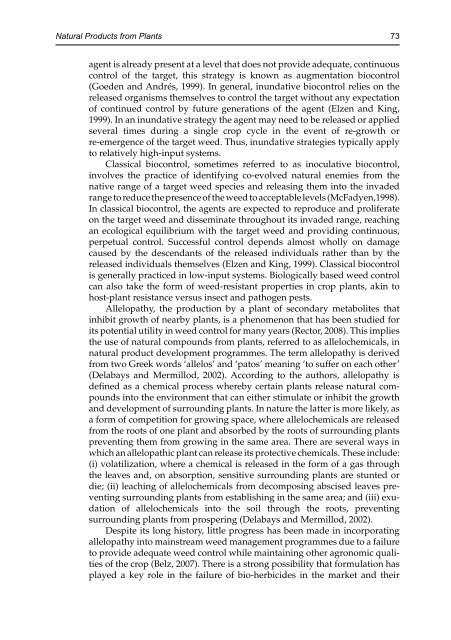natural-products-in-plant-pest-management
natural-products-in-plant-pest-management
natural-products-in-plant-pest-management
Create successful ePaper yourself
Turn your PDF publications into a flip-book with our unique Google optimized e-Paper software.
Natural Products from Plants 73agent is already present at a level that does not provide adequate, cont<strong>in</strong>uouscontrol of the target, this strategy is known as augmentation biocontrol(Goeden and Andrés, 1999). In general, <strong>in</strong>undative biocontrol relies on thereleased organisms themselves to control the target without any expectationof cont<strong>in</strong>ued control by future generations of the agent (Elzen and K<strong>in</strong>g,1999). In an <strong>in</strong>undative strategy the agent may need to be released or appliedseveral times dur<strong>in</strong>g a s<strong>in</strong>gle crop cycle <strong>in</strong> the event of re-growth orre- emergence of the target weed. Thus, <strong>in</strong>undative strategies typically applyto relatively high-<strong>in</strong>put systems.Classical biocontrol, sometimes referred to as <strong>in</strong>oculative biocontrol,<strong>in</strong>volves the practice of identify<strong>in</strong>g co-evolved <strong>natural</strong> enemies from thenative range of a target weed species and releas<strong>in</strong>g them <strong>in</strong>to the <strong>in</strong>vadedrange to reduce the presence of the weed to acceptable levels (McFadyen,1998).In classical biocontrol, the agents are expected to reproduce and proliferateon the target weed and dissem<strong>in</strong>ate throughout its <strong>in</strong>vaded range, reach<strong>in</strong>gan ecological equilibrium with the target weed and provid<strong>in</strong>g cont<strong>in</strong>uous,perpetual control. Successful control depends almost wholly on damagecaused by the descendants of the released <strong>in</strong>dividuals rather than by thereleased <strong>in</strong>dividuals themselves (Elzen and K<strong>in</strong>g, 1999). Classical biocontrolis generally practiced <strong>in</strong> low-<strong>in</strong>put systems. Biologically based weed controlcan also take the form of weed-resistant properties <strong>in</strong> crop <strong>plant</strong>s, ak<strong>in</strong> tohost-<strong>plant</strong> resistance versus <strong>in</strong>sect and pathogen <strong>pest</strong>s.Allelopathy, the production by a <strong>plant</strong> of secondary metabolites that<strong>in</strong>hibit growth of nearby <strong>plant</strong>s, is a phenomenon that has been studied forits potential utility <strong>in</strong> weed control for many years (Rector, 2008). This impliesthe use of <strong>natural</strong> compounds from <strong>plant</strong>s, referred to as allelochemicals, <strong>in</strong><strong>natural</strong> product development programmes. The term allelopathy is derivedfrom two Greek words ‘allelos’ and ‘patos’ mean<strong>in</strong>g ‘to suffer on each other’(Delabays and Mermillod, 2002). Accord<strong>in</strong>g to the authors, allelopathy isdef<strong>in</strong>ed as a chemical process whereby certa<strong>in</strong> <strong>plant</strong>s release <strong>natural</strong> compounds<strong>in</strong>to the environment that can either stimulate or <strong>in</strong>hibit the growthand development of surround<strong>in</strong>g <strong>plant</strong>s. In nature the latter is more likely, asa form of competition for grow<strong>in</strong>g space, where allelochemicals are releasedfrom the roots of one <strong>plant</strong> and absorbed by the roots of surround<strong>in</strong>g <strong>plant</strong>sprevent<strong>in</strong>g them from grow<strong>in</strong>g <strong>in</strong> the same area. There are several ways <strong>in</strong>which an allelopathic <strong>plant</strong> can release its protective chemicals. These <strong>in</strong>clude:(i) volatilization, where a chemical is released <strong>in</strong> the form of a gas throughthe leaves and, on absorption, sensitive surround<strong>in</strong>g <strong>plant</strong>s are stunted ordie; (ii) leach<strong>in</strong>g of allelochemicals from decompos<strong>in</strong>g abscised leaves prevent<strong>in</strong>gsurround<strong>in</strong>g <strong>plant</strong>s from establish<strong>in</strong>g <strong>in</strong> the same area; and (iii) exudationof allelochemicals <strong>in</strong>to the soil through the roots, prevent<strong>in</strong>gsurround<strong>in</strong>g <strong>plant</strong>s from prosper<strong>in</strong>g (Delabays and Mermillod, 2002).Despite its long history, little progress has been made <strong>in</strong> <strong>in</strong>corporat<strong>in</strong>gallelopathy <strong>in</strong>to ma<strong>in</strong>stream weed <strong>management</strong> programmes due to a failureto provide adequate weed control while ma<strong>in</strong>ta<strong>in</strong><strong>in</strong>g other agronomic qualitiesof the crop (Belz, 2007). There is a strong possibility that formulation hasplayed a key role <strong>in</strong> the failure of bio-herbicides <strong>in</strong> the market and their


